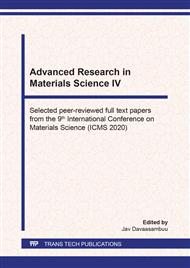[1]
J. Temuujin, T. Jadambaa, G. Burmaa, S. Erdenechimeg, J. Amarsanaa, and K. J. D. MacKenzie, Characterisation of acid activated montmorillonite clay from Tuulant (Mongolia), Ceram. Int. 30 (2004) 251–255.
DOI: 10.1016/s0272-8842(03)00096-8
Google Scholar
[2]
L. Bieseki, H. Treichel, A. S. Araujo, S. Berenice, and C. Pergher, Applied Clay Science Porous materials obtained by acid treatment processing followed by pillaring of montmorillonite clays, Appl. Clay Sci. 85 (2013) 46–52.
DOI: 10.1016/j.clay.2013.08.044
Google Scholar
[3]
I. Chaari, M. Medhioub, F. Jamoussi, and A. H. Hamzaoui, Acid-treated clay materials (Southwestern Tunisia) for removing sodium leuco-vat dye: Characterization, adsorption study and activation mechanism, submitted to J. Mol. Struct., (2020).
DOI: 10.1016/j.molstruc.2020.128944
Google Scholar
[4]
W.S. Lima, A.L.F. Brito, M.G.F. Rodriques, M.F. Mota, M.M. Silva, Characterization of National Clays After Acid Treatment and Thermal, Material Science Forum, 85 (2015) 662-666.
DOI: 10.4028/www.scientific.net/msf.805.662
Google Scholar
[5]
T. Yamaguchi, T. Yoshimura, T. Yamakami, S. Taruta, and K. Kitajima, Preparation of novel porous solids from alumina-pillared fluorine micas by acid-treatment, Microporous Mesoporous Mater., 111 (2008) 285–291.
DOI: 10.1016/j.micromeso.2007.08.003
Google Scholar
[6]
P. Komadel and J. Madejová, Acid activation of clay minerals, in: F.Bergaya, G.Lagaly (Eds.), Development in Clay Science, 2nd ed., Elsevier Ltd., 2013, pp.385-409.
DOI: 10.1016/b978-0-08-098258-8.00013-4
Google Scholar
[7]
G. Lagaly, Acid activation of clay minerals ´ p. komadel and j. madejova, 1 (2006) 263–287.
Google Scholar
[8]
A. Senthilnathan, S. Dissanayake, G. T. D. Chandrakumara, and P. G. Mantilaka, Akaganeite nanorices deposited muscovite mica surfaces as sunlight active green photocatalyst, submitted to R.Soc.open sci, 6 (2019).
DOI: 10.1098/rsos.182212
Google Scholar
[9]
A. Senthilnathan, U. G. M. Ekanayake, S. Dissanayake, and P. G. Mantilaka, In-Situ Synthesis of Zinc Oxide Nano-Seeds on Muscovite Mica Sheets as A Highly Active Photocatalyst Open Access In-Situ Synthesis of Zinc Oxide Nano-Seeds on Muscovite Mica Sheets as A Highly Active Photocatalyst, Journal of Nanoscience Research, 1 (2020) 5-14.
DOI: 10.1098/rsos.182212
Google Scholar
[10]
W. Wang et al., International Journal of Biological Macromolecules Pb ( ΙΙ ) removal from water using porous hydrogel of chitosan-2D montmorillonite M : Montmorillonite, Int. J. Biol. Macromol. 128 (2019) 85–93.
DOI: 10.1016/j.ijbiomac.2019.01.098
Google Scholar
[11]
M. Orta, F. M. Flores, C. F. Morantes, and R. M. T. Sánchez, Interrelations of structure, electric surface charge, and hydrophobicity of organo-mica and –montmorillonite, tailored with quaternary or primary amine cations, Mater. Chem. Phys. 223 (2018) 325-335.
DOI: 10.1016/j.matchemphys.2018.10.059
Google Scholar
[12]
V.C. Farmer, The layer silicates, in: V.C. Farmer (Eds.), Infrared Spectra of Minerals, Monograph 4, Mineralogical Society, London, UK, 1974, p.331–363.
Google Scholar
[13]
B. Velde, Infrared spectra of synthetic micas in the series muscovite-MgAl celadonite, Am. Miner. 63 (1978) 343–349.
Google Scholar
[14]
J.D. Russell, A.R. Fraser, Infrared methods, in: M.J. Wilson (Eds.), Clay Mineralogy: Spectroscopic and Chemical Determinative Methods, Chapman & Hall, London, UK, 1994, p.11–67.
DOI: 10.1007/978-94-011-0727-3_2
Google Scholar
[15]
J. Madejová, W.P. Gates, S. Petit, IR spectra of clay minerals, in: W.P. Gates, J.T. Klopprogge, J. Madejová, F. Bergaya (Eds.) Infrared and Raman Spectroscopies of Clay Minerals, Elsevier, Amsterdam, The Netherlands, 2017, p.107–149.
DOI: 10.1016/b978-0-08-100355-8.00005-9
Google Scholar
[16]
Ts. Zolzaya, G. Oyun-Erdene, J. Temuujin, Characterization of mica from Bodonchiin gol deposit (Mongolia), Bulletin of the Institute of Chemistry and Chemical Technology, MAS, 7 (2019) 23-27.
DOI: 10.5564/bicct.v0i7.1269
Google Scholar
[17]
I.I. Plyusnina, Infrared Spectra of Minerals, Mosk.Gos.Uni., Moscow, (1977).
Google Scholar
[18]
M. Krol, J. Minkiewicz, W. Mozgawa, IR spectroscopy studies of zeolites in geopolymeric materials derived from kaolinite, J. Mol. Struct. (2016) 1-7.
DOI: 10.1016/j.molstruc.2016.02.027
Google Scholar


